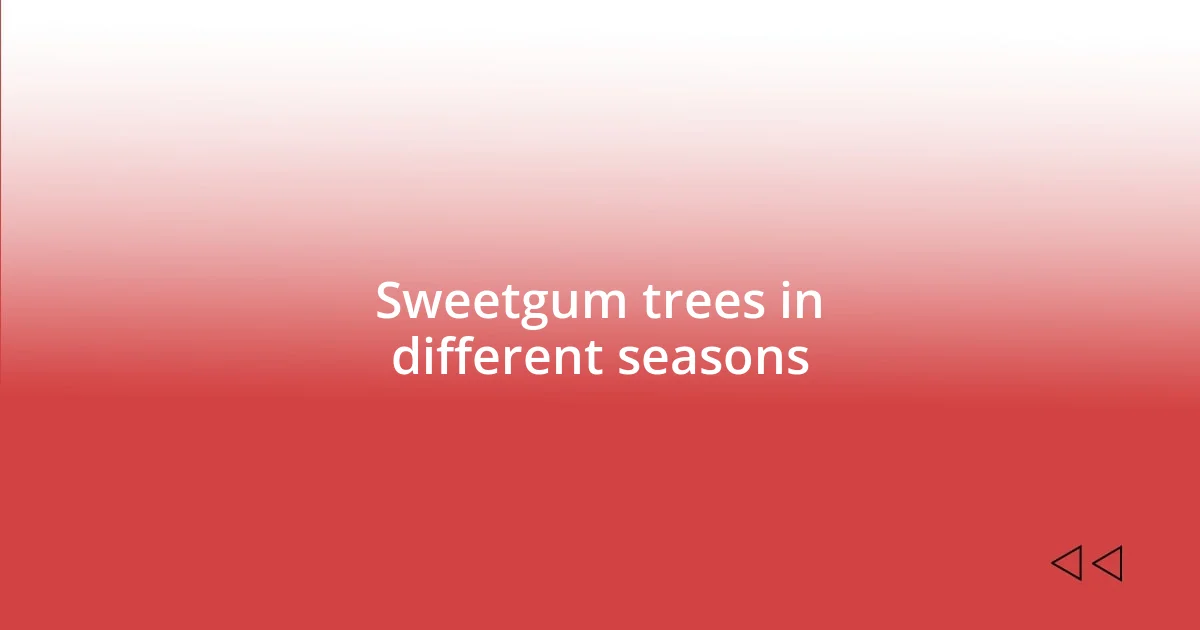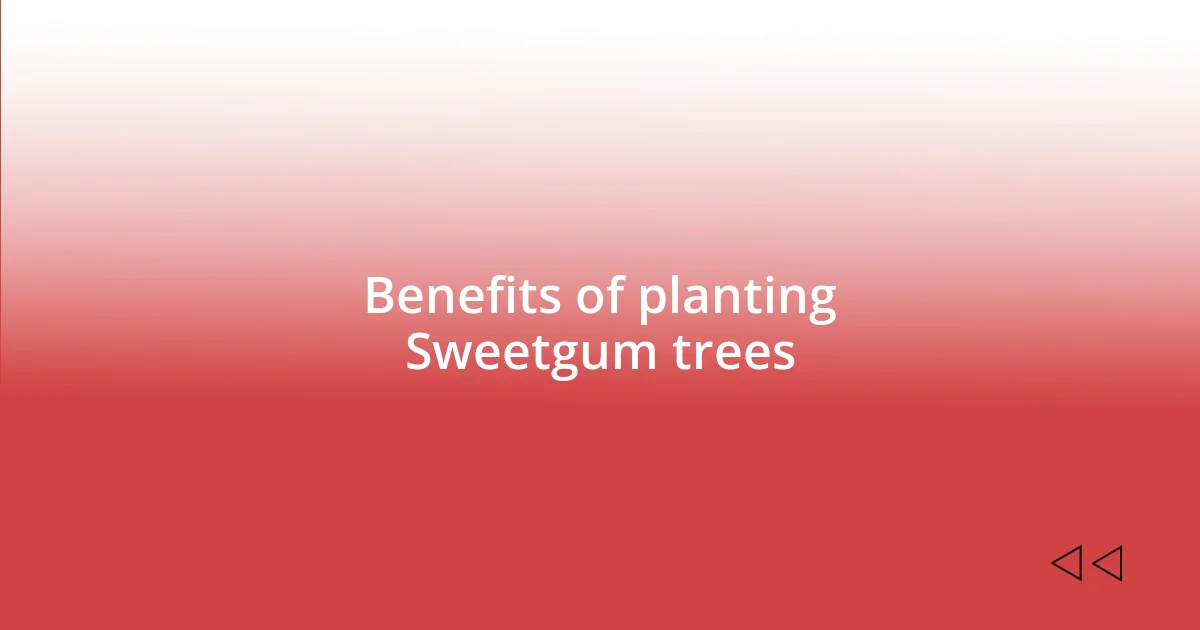Key takeaways:
- Sweetgum trees (Liquidambar styraciflua) are celebrated for their stunning fall colors and resilience in various environments.
- These trees provide ecological benefits, including habitat for wildlife, air quality improvement, and enhanced soil health.
- In landscaping, sweetgum trees can serve as focal points, complement mixed plantings, and improve privacy in smaller yards.

Introduction to Sweetgum trees
Sweetgum trees, known scientifically as Liquidambar styraciflua, hold a special place in my heart, perhaps because of their dazzling fall colors that transform ordinary landscapes into breathtaking vistas. Have you ever walked through a forest carpeted in vibrant reds, oranges, and yellows? Each autumn, I find myself captivated by how these trees, with their star-shaped leaves, can evoke such intense emotions, from nostalgia to sheer awe.
What’s fascinating about the sweetgum is its resilience; it thrives in a variety of soil types and can adapt to different environments. I remember planting one in my backyard years ago, eager to witness its growth. Watching it flourish over time has been a reminder of nature’s beauty and tenacity. It’s this kind of personal connection that makes the sweetgum tree more than just a botanical name; it’s a living testament to the cycles of life.
Beyond their striking aesthetics, sweetgum trees play a vital role in their ecosystems. Their unique, spiky seed balls, while often trodden on, are a food source for many birds and small mammals. Isn’t it interesting to consider how such a beautiful tree not only enriches our visual landscape but also supports wildlife? Each part of the sweetgum seems to tell a story, adding layers to our understanding and appreciation of nature.

Characteristics of Sweetgum trees
Sweetgum trees are easily recognizable by their distinct star-shaped leaves, typically showcasing five pointed lobes. I vividly recall the first time I stumbled upon a mature sweetgum during a hike. Its vibrant foliage stood like a natural fan, reaching out in all directions, creating a unique silhouette against the crisp blue sky. This characteristic not only adds beauty to the landscape but also serves a purpose, as those leaves can capture sunlight efficiently, enhancing the tree’s growth.
The bark of the sweetgum is another remarkable feature. It has a rough, furrowed texture that’s easy to spot, often displaying deep ridges and a grayish-brown color. I’ve touched these trees countless times, running my fingers along these ridges and feeling the history of the tree in my palms. Each groove tells a story of resilience against the elements, and it reminds me that beauty often comes with strength.
When it comes to size, sweetgum trees are quite impressive. They can reach heights of up to 75 feet with a spread of 50 feet, making them an outstanding presence in any landscape. I remember visiting a botanical garden where a sweetgum towered over me, its branches swaying in the wind. It felt both humbling and exhilarating to stand beneath such a magnificent structure, a true testament to nature’s artistry and endurance.
| Characteristic | Description |
|---|---|
| Leaf Shape | Star-shaped with five pointed lobes |
| Bark Texture | Rough and furrowed, grayish-brown |
| Height | Can reach up to 75 feet |

Sweetgum trees in different seasons
When I think about sweetgum trees throughout the seasons, each stage reveals a different facet of their charm. In spring, the trees burst into life with a vibrant green canopy, bringing a refreshing energy to suburban yards and woodland trails alike. I often find myself drawn to their vivid foliage, the way sunlight dances through the leaves, casting playful shadows on the ground below.
- Spring: Fresh green leaves and delicate flowers bloom, signaling revitalization.
- Summer: Full, lush foliage provides cool shade, making it a perfect spot for lazy afternoon picnics.
- Autumn: A spectacular transformation occurs as vibrant reds, oranges, and yellows create a breathtaking tapestry.
- Winter: The bare branches emerge stark against the winter sky, showcasing the tree’s unique structure while the spiky seed balls cling on, adding a touch of character even in the cold months.
As much as I adore the fall, sweetgums in winter have a stark beauty that’s hard to overlook. Last December, I took a walk in a nearby nature reserve and marveled at the trees’ skeletal forms, their silhouettes stretching like intricate lace against the backdrop of a pale blue sky. This minimalist elegance reminds me that beauty often lies in simplicity and the bare essence of life, highlighting the resilience that sweetgum trees embody throughout the year.

Benefits of planting Sweetgum trees
Planting sweetgum trees offers numerous ecological benefits that often go unrecognized. One of my favorite aspects is how their canopy provides shelter for various animals, creating a vibrant habitat. Just a few weekends ago, I was in my backyard and watched a pair of squirrels darting among the branches, their playful antics bringing a smile to my face. Have you ever noticed how the presence of wildlife can transform an ordinary day into an extraordinary one?
Another vital benefit is their ability to improve air quality. Sweetgum trees are excellent at absorbing carbon dioxide and releasing oxygen, which contributes to our overall well-being. I remember planting my first sweetgum sapling and envisioning it growing tall and strong. As it shades my home while cleaning the air, I can’t help but feel a sense of accomplishment, knowing I’m making a positive impact on the environment.
Additionally, sweetgum trees enhance soil health through their deep root system. This root structure not only prevents erosion but also helps retain moisture, which is essential during dry spells. Watching my sweetgum’s roots intertwine with the earth reminds me of a hidden network, silently working to sustain the ecosystem. Doesn’t it feel rewarding to be part of nature’s intricate design?

Landscaping ideas with Sweetgum trees
When landscaping with sweetgum trees, consider their natural, towering presence as a focal point in your yard. I once planted a sweetgum next to my patio, and it quickly became a stunning backdrop for summer barbecues. The way its majestic leaves flutter in the breeze adds a serene touch that makes even a simple gathering feel special.
Sweetgum trees also work wonders in a mixed planting bed. Recently, I combined them with flowering perennials and ornamental grasses, creating a delightful contrast. The vivid foliage of the sweetgum adds height and depth, while the colorful blooms bring bursts of life throughout the seasons. Pairing them this way not only draws the eye but also invites butterflies, turning my garden into a lively sanctuary.
For those with smaller yards, consider using sweetgum trees as a vertical element against fences or walls. I remember transforming a narrow side yard by planting a vertical row of sweetgums, which has now become an eye-catching living screen. This approach offers privacy while showcasing their seasonal beauty, proving that even a limited space can shine with the right landscaping ideas!















